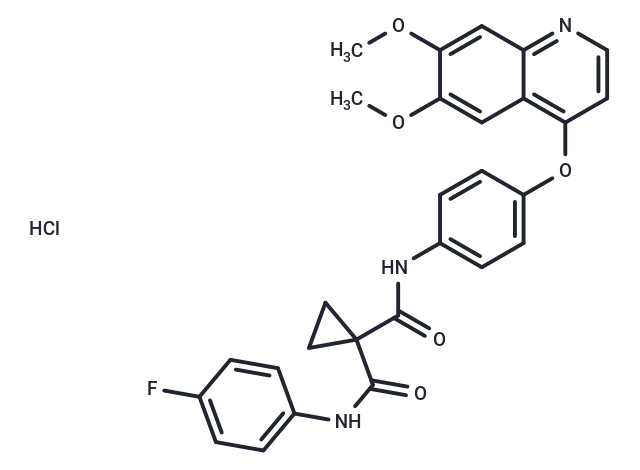Shopping Cart
- Remove All
 Your shopping cart is currently empty
Your shopping cart is currently empty

Cabozantinib hydrochloride (XL184) is a potent pan-tyrosine kinases inhibitor that inhibits VEGFR2, c-Met, Kit, Axl, and Flt4 (IC50s: 0.035, 1.3, 4.6, 7 and 6 nM).

| Pack Size | Price | Availability | Quantity |
|---|---|---|---|
| 1 mg | $37 | In Stock | |
| 2 mg | $50 | In Stock | |
| 5 mg | $63 | In Stock | |
| 10 mg | $98 | In Stock | |
| 25 mg | $172 | In Stock | |
| 50 mg | $260 | In Stock | |
| 100 mg | $367 | In Stock | |
| 200 mg | $598 | In Stock | |
| 500 mg | $956 | In Stock |
| Description | Cabozantinib hydrochloride (XL184) is a potent pan-tyrosine kinases inhibitor that inhibits VEGFR2, c-Met, Kit, Axl, and Flt4 (IC50s: 0.035, 1.3, 4.6, 7 and 6 nM). |
| Targets&IC50 | RORγ:111 nM (Ki), RORα:172 nM (Ki) |
| Alias | XL184, Cabozantinib hydrochloride (849217-68-1(free base)), BMS-907351 |
| Molecular Weight | 537.96 |
| Formula | C28H25ClFN3O5 |
| Cas No. | 1817759-42-4 |
| Smiles | Cl.COc1cc2nccc(Oc3ccc(NC(=O)C4(CC4)C(=O)Nc4ccc(F)cc4)cc3)c2cc1OC |
| Relative Density. | no data available |
| Storage | Powder: -20°C for 3 years | In solvent: -80°C for 1 year | Shipping with blue ice. | ||||||||||||||||||||
| Solubility Information | DMSO: 5.38 mg/mL (10 mM), Sonication is recommended. | ||||||||||||||||||||
Solution Preparation Table | |||||||||||||||||||||
DMSO
| |||||||||||||||||||||

Copyright © 2015-2025 TargetMol Chemicals Inc. All Rights Reserved.